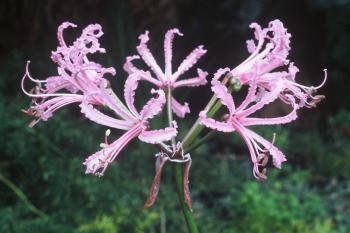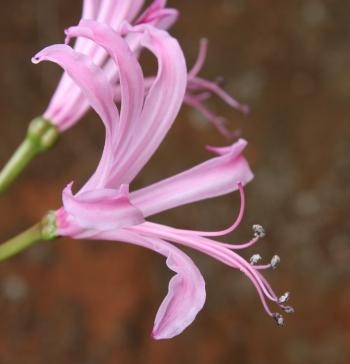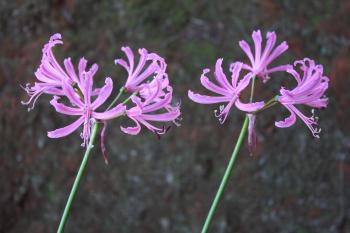Nerine bowdenii
Nerine bowdenii W.Watson
Family: Amaryllidaceae
Common names: large pink nerine (Eng.); grootpienknerina (Afr.)
Introduction
Nerine bowdenii is an autumn-flowering geophyte with impressive, large, pink or rarely pure white blooms, carried on long sturdy stems. It is the most important nerine in ornamental horticulture, highly valued for its cold tolerance, suitability as a container subject and massed bedding plant, and for its long-lasting cut flowers.

Description
Description
This deciduous, summer-growing nerine reaches up to 700 mm high in flower, and grows from a globose, offset-forming bulb, with a prominent neck. It has 6–8 arching, light green, strap-shaped leaves, produced in two opposite rows. The flower buds emerge towards the end of the growing season, from late summer to late autumn. They develop into hemispherical heads of widely flared, bright pink or rarely pure white flowers with recurved tips and slightly wavy or heavily curled tepal upper margins. The stamens and style are strongly declinate (bent downwards and upwards). The stamens have cream-coloured pollen and the stigma has minute stigmatic lobes. The egg-shaped fleshy seeds are produced in a subglobose capsule with thin membranous walls.

Nerine bowdenii comprises two subspecies, subsp. bowdenii and subsp. wellsii C.A.Norris ex G.D.Duncan. The subsp. wellsii differs from subsp. bowdenii in having smaller flowers with shorter, narrower tepals with heavily curled upper margins, longer flower stems and longer, wider leaves. In addition, it has a much longer flowering period, from January to May, versus April to May in subsp. bowdenii.

Conservation Status
Status
According to the Red List of South African Plants, the conservation status of this plant is Rare, as it is known from only nine subpopulations. However, it is not threatened, due to its largely inaccessible habitat.
Distribution and habitat
Distribution description
Nerine bowdenii is native to the Eastern Cape and KwaZulu-Natal. The subsp. bowdenii occurs in the central and southeastern parts of the Eastern Cape and in southern KwaZulu-Natal. Very little information was recorded about the habitat where this subspecies was originally found in the Eastern Cape, but its habitat in southern KwaZulu-Natal is embankments along margins of Afromontane mistbelt forest, from 1 250 to 1 550 m altitude. The subsp. wellsii is endemic to high altitude terrain from 2 400–3 300 m at Mont-aux-Sources, a colossal mountain block located high on the rim of the northeastern edge of the Drakensberg, in western KwaZulu-Natal. The area experiences heavy summer rain (October to March) and dry, cold winters (June to August), where overnight temperature can drop to -15°C. The plants occur in large drifts in moist seepage zones on basalt ledges, steep, grassy mountainsides, under overhanging basalt cliffs and in rock crevices, in fertile black loam, in uKhalamba Basalt Grassland. This subspecies frequently occurs in close association with Eucomis bicolor, the Forest Pineapple Flower.

Nerine bowdenii is best suited to cultivation in summer-rainfall areas which experience cold winters with frost. It can also be grown in winter-rainfall areas, but requires a dry winter rest.
Derivation of name and historical aspects
History
The English cleric Rev. William Herbert established the genus Nerine in 1820 when he described N. rosea (now N. sarniensis) in Curtis’s Botanical Magazine, naming it for Nerine, a guardian sea nymph sent by the Roman goddess Venus to rescue Vasco da Gama's armada en route to India.
The first collection of subsp. bowdenii was made by the South African amateur botanist, Ernest Galpin, who found it in June 1894, northeast of Queenstown, in the central Eastern Cape. A second collection was made in about 1898 by Athelstan H. Cornish-Bowden (1871–1942), an Englishman who served as Surveyor-General of the Cape Colony. His material is thought to have been collected in the vicinity of King William’s Town, in the eastern part of the Eastern Cape, but its precise location, was unfortunately not recorded. He sent bulbs to his mother in South Devon in the United Kingdom, where they flowered, and she distributed bulbs to various growers, including the nurserymen Veitch & Son of Exeter, and Kew Gardens. Having seen flowering material of the bulbs at Kew, the English horticulturist and botanist William Watson described the species in 1904 in the November edition of The Gardeners’ Chronicle, naming it in tribute to Athelstan Cornish-Bowden.
Numerous variants of this subspecies have arisen in cultivation, particularly in the United Kingdom, many of which have acquired cultivar names, and it has also been used in hybridisation programmes with the winter-growing N. sarniensis. Amongst the few habitat collections made of this subspecies during the latter part of the 20th century, is one made in June 1980, by the then Kirstenbosch horticulturist Koos Roux, who found it between Kokstad and Harding, in southern KwaZulu-Natal. Plants of this collection continue to be grown in the bulb nursery at Kirstenbosch.
The earliest collections of subsp. wellsii were made by Bayer & McClean in 1926 and by Humbert in 1934 at Mont-aux-Sources, in the northern KwaZulu-Natal Drakensberg. In the late 1940’s, material from the same area was collected by Dr Arthur Quinton Wells, a resident of Oxfordshire, who introduced the plant into England. The nerine enthusiast and amateur botanist, Tony Norris, correctly considered the northern Drakensberg plants to be morphologically distinct from the Eastern Cape ones, and to warrant status as a subspecies, and in 1974 he published the name Nerine bowdenii subsp. wellsii for these plants. Unfortunately he did not designate any type material along with his description, and the name was thus invalid, however, in a recent paper in Curtis’s Botanical Magazine, the name has been validated (Duncan 2014).
Nerine is a genus of 23 species endemic to the southern African countries of Botswana, Lesotho, Namibia, South Africa and Swaziland. It is represented in all provinces of South Africa, and concentrated in the eastern summer-rainfall zone, especially the Eastern Cape. Other noteworthy members include the sparkling red or pink N. sarniensis from the Western Cape mountains, renowned for its long-lived cut flowers, the pink N. humilis, another Western Cape member noted for its massed autumn displays following summer bush fires, and the grass-leafed, bright pink N. filifolia from the Eastern Cape, one of the most easily cultivated species. N. bowdenii superficially resembles N. ridleyi in its large pink flower heads with declinate stamens and style, but the latter is a winter-growing species with broader, grey-green leaves, and native to the Hex River-, Franschhoek- and Wemmershoek Mountains of the southwestern Cape.
Ecology
Ecology
Nerine bowdenii is a deciduous, summer-growing plant, adapted to survival in high altitude mountainous terrain. Flowering takes place in late summer to autumn, from January to May, mostly towards the end of the growing period, but sometimes while the plants are still in green leaf. The bulbs are completely dormant in winter, but have perennial fleshy roots. The flowers are at least partially self-fertile in cultivation, usually producing a few seeds in enclosed, insect-free conditions. In the northern Drakensberg, the subsp. wellsii is pollinated by the brown, long-tongued fly, Prosoeca ganglbaueri, which feeds on the nectar droplet located at the base of the very short perianth tube. As the ripening seeds enlarge, they rupture the thin, membranous capsule walls and fall to the ground, close to the mother plant, or roll away over rock surfaces, taking root in humus-rich crevices. The water-rich, fleshy seeds have no dormant period but germinate almost immediately, quickly forming a leaf and a small bulb before the onset of the cold, dry winter.

Uses
Use
Nerine bowdenii has no known medicinal or magical uses, but cultivars of this plant are widely grown as bedding plants and for their cut flowers, especially in the United Kingdom. Members of the family Amaryllidaceae contain toxic alkaloid compounds and all parts of this plant should be regarded as at least mildly toxic if ingested.

Growing Nerine bowdenii
Grow
Nerine bowdenii is an outstanding choice for garden beds, herbaceous borders, rock garden pockets and containers. It likes a well-drained, neutral or slightly acid garden loam when grown outdoors, or loam-based potting compost when grown in containers. The bulbs perform poorly in very hot or dry positions; in temperate climates, choose a position receiving morning sun and afternoon shade, but in cold climates of the northern hemisphere, plant the bulbs in full sun or against a south-facing wall. The subsp. wellsii and cultivars of subsp. bowdenii are hardy outdoors in even the coldest parts of the United Kingdom, but in Cape Town’s mild coastal climate, where winter temperatures rarely drop below 5°C, subsp. bowdenii flowers reasonably well, but subsp. wellsii from high altitude, seldom flowers. Even in the best of conditions, flowering in N. bowdenii is erratic, requiring careful selection and propagation of relatively free-flowering clones.
In temperate and warm climates, plant the bulbs with the top of the neck just above soil level. In cold climates, plant the bulbs with the top of the neck resting up to 3 cm below soil level, and cover with thick dry mulch during the winter dormant phase. When in active growth in summer, provide regular deep watering about twice per week, but during the winter dormant period, keep the soil dry. Like all nerines, N. bowdenii has perennial roots that resent disturbance, so once established, allow the bulbs to remain undisturbed for four or five years. In addition to garden cultivation, both subspecies are suited to cultivation in containers. The bulbs are gregarious, so for best results, plant them close together (about 5 cm apart). Both subspecies are highly recommended as cut flowers, although subsp. wellsii is longer-lasting.
Propagate N. bowdenii by sowing the seeds as soon as they are easily removed from the membranous capsules. Lightly press the seeds into a well-drained sowing medium, such as equal parts of coarse river sand and finely milled acid bark, and keep slightly moist by watering with a fine rose about twice per week. At the beginning of the third growing season, pot-up the seedlings into permanent containers or plant out into garden beds. Alternatively, divide thick clumps in early spring by carefully separating the bulbs, retaining as many roots as possible, and replant immediately.
The bulbs are highly susceptible to mealy bug infestation when grown in containers, especially in enclosed conditions like greenhouses, so provide a well-ventilated environment as far as possible. In severe infestations, treat with an annual drench of systemic insecticide containing the active ingredient imidacloprid at the start of the active growing period in spring. Control of mealy bug is very important as it is a transmitter of viral disease. Slugs and snails relish the leaves of this species, and also transmit viral disease. In South Africa, lily borer caterpillars are partial to the leaves and bulbs, and snout beetles chew the leaf margins.
References
- Duncan, G.D. 2002. Grow nerines: Kirstenbosch Gardening Series. National Botanical Institute, Cape Town.
- Duncan, G.D. 2008. Nerine ridleyi. Curtis’s Botanical Magazine 25 (2): 122–131.
- Duncan, G.D. 2014. Nerine bowdenii subsp. wellsii. Curtis’s Botanical Magazine 31(3): 223–237.
- Norris, C.A. 1974. The genus Nerine. Bulletin of the Nerine Society 6: 7–31.
- Watson, W. 1904. Nerine bowdenii. The Gardeners’ Chronicle (Series 3) 36: 365.
- Zonneveld, B.J.M. & Duncan, G.D. 2006. Genome size for the species of Nerine Herb. (Amaryllidaceae) and its evident correlation with growth cycle, leaf width and other morphological characters. Plant Systematics and Evolution 257: 251–260.
Credits
Graham Duncan
Kirstenbosch National Botanical Garden
November 2015
Plant Attributes:
Plant Type: Bulb
SA Distribution: Eastern Cape, KwaZulu-Natal
Soil type: Loam
Flowering season: Late Summer, Autumn
PH: Acid, Neutral
Flower colour: White, Pink
Aspect: Morning Sun (Semi Shade)
Gardening skill: Easy
Special Features:
Horticultural zones











Rate this article
Article well written and informative
Rate this plant
Is this an interesting plant?
Login to add your Comment
Back to topNot registered yet? Click here to register.